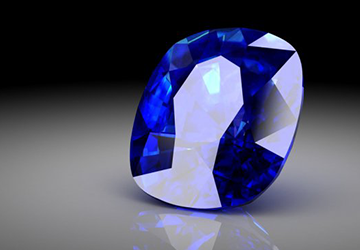The sapphire, a symbole of intense blue

The sapphire, a symbole of intense blue
IT’S ORIGIN
The earliest traces of sapphires date back to Greece in the 5th century BC. At that time, this precious stone was defined by the name “sappheiros”, meaning “blue”, and its colour was quickly recognised as a dominant feature in its history. The Egyptians, Romans and Persians all revered this stone, which they considered to be sacred and a symbol of justice. Later, the Catholic Church would give this stone an important status within the church. As a sacred symbol of purity, cardinals wore a sapphire ring on their right hand, the hand that was used to give blessings.
This strong, sacred image that the stone has continued to convey over the years is even called “the stone of the Popes” in the religious world. It is also used in the field of lithotherapy to calm mental activity, stimulate creativity and concentration, and ease sorrow and foster spiritual elevation. Sapphires are often associated with the celestial universe and the Persians believed that the blue of the sky was due to the reflections of this mesmerising stone. It is also for this same reason, deeply rooted in the spiritual origins of the sapphire that these jewels were traditionally set on many crowns during coronations. A romantic, dreamlike and allegorical universe that is the perfect representation of this intense blue gemstone.
As the birthstone for September, the sapphire is the icon of truth, peace and loyalty.
CHARACTERISTICS
A precious stone, like rubies or emeralds, the sapphire is a member of the vast family of corundums which includes many gemstones of multiple colours. The different colour variations are due to the fact that it is made of aluminium oxide. Famous for its blue colour, sapphires can also be brown, pink, violet, orange, yellow, green, transparent… These different tones depend on the precise chemical composition of the stone, for example nickel will bring out the yellow, iron combined with titanium, will produce blue. However, in order to be called a sapphire, the gem will have to be entirely blue. For the other colours, the stone will be referred to as a “fancy coloured sapphire” or by a specific name such as Padparadscha Sapphire, which has an intense and rare pink/orange colour.
Among the most mythical sapphire deposits is the one in Sri Lanka. Traditionally, the Ceylon mine was renowned for its exceptionally fine blue sapphires, but now all colours of this coveted gem are extracted. In addition to Sri Lanka, some of the world’s leading sapphire producers for the jewellery market include Tanzania, Burma, India, Cambodia, Vietnam, Thailand, Australia and Madagascar.
In terms of hardness, this stone is 9 on the Mohs scale, while diamonds are 10 on the same scale. Sapphire density ranges from 3.80 to 4.05 and its melting temperature is 2050°.
Another rare and coveted feature of this stone is the star sapphire. This natural phenomenon is due to inclusions made up of rutiles arranged on multiple axes which reflect light in a very particular way. As a result, an asterisk shape is visible on the stone, also known as a “star”.
VALUE
While the size, quality and number of carats of a stone is very important in determining its value, colour also plays an essential role. The more intense, deep and dark the colour of the stone, the higher the price. For example, an almost black and opaque Australian sapphire with green undertones, or a very light Madagascan sapphire will be worth very little.
As a guide, a non-exhaustive colour chart exists for finding the best Blue Sapphire. In this list you will find the cornflower blue sapphire (Kashmir), royal blue with a few hints of purple (Sri Lanka) and midnight blue with intense and contrasting tones (Republic of Myanmar, Burma). However, there is no exact classification for the price of a sapphire, such as the 4C’s for diamonds, the value of the stone will also depend on the appreciation of the seller and the buyer’s own personal preference.
The price of a Blue Sapphire in the traditional jewellery market can vary from 200 euros to 3,000 euros per carat. However, this price range also depends on market demand and the overall quality of the stone.
To date, the largest and most expensive blue sapphire in the world is called the “blue star sapphire”. Discovered in Sri Lanka, in Ratnapura, a town that is renowned for its gemstones. This unique star sapphire is estimated to be worth at least $100 million for its 1404.49 carats. The owner of the stone, who wishes to remain anonymous, explains that he could not pass up the chance to purchase this natural treasure with its outstanding properties.
OUR SAPPHIRE JEWELLERY
With its rich and diverse colour palette, the sapphire has an important place in the world of High Jewellery. At Atelier Mariusse & Bonnet, three unique creations are paved with this precious stone: the Winter ring, with its blue sapphires, as well as the Autumn ring and the Tutti Frutti ring with fancy coloured sapphires.
This extremely elegant and prestigious gem would make a perfect gift for a loved one on an important occasion.
To learn more about these Mariusse & Bonnet creations: Winter Ring, Autumn Ring, Tutti Frutty Ring or to have more information about our French artisanal workshop, you can email us at contact@mariusse-bonnet.com. Our entire team of jewellers is at your disposal.